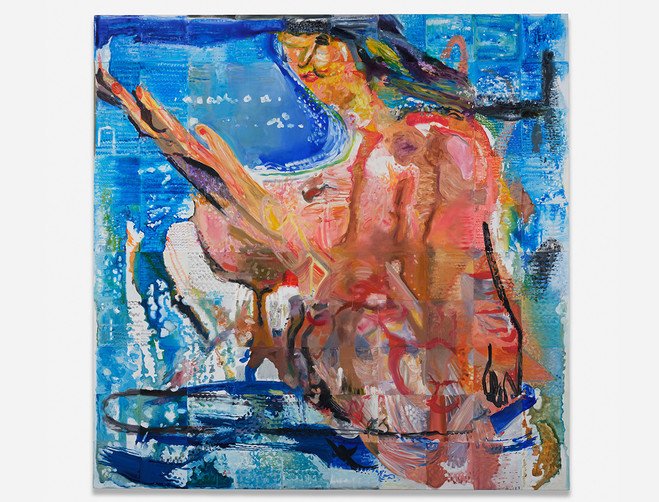Albert Oehlen — Endless Summer
Exhibition

Albert Oehlen
Endless Summer
Ends in 4 days: October 20 → December 20, 2025
Galerie Max Hetzler, Paris, is pleased to present Endless Summer, a solo exhibition of new and recent paintings by Albert Oehlen. Taking the theme of the bather as a point of departure, Oehlen’s paintings shift, in characteristic style, between ostensible figuration and intangible abstraction.
In this body of richly painted canvases, Oehlen presents numerous iterations of a dark-haired female nude. She is, at times, portrayed against a searing sky-blue backdrop. At others, sparse areas of canvas are left intentionally blank, or else are filled with a myriad of colours, textures and forms. Drawing on the prominence of the bather as a muse throughout the canon of art history, this recurring motif simultaneously alludes to a small painting by John Graham (1886–1961) which has occupied the artist’s imagination — almost to the point of obsession — for more than three decades. Titled Tramonto Spaventoso (Terrifying Sunset), 1940–1949, the painting presents a curious ensemble of characters and forms, most notably including a bespectacled self-portrait of Graham with a curling, Dalí-esque moustache, and a dark-haired mermaid in profile view, whose fluid figure forms the basis of Oehlen’s current cycle of paintings.
Oehlen first discovered Graham’s painting in the 1990s, as a small illustration in a book by Dore Ashton on the New York School. ‘It was reproduced in black and white and it fascinated me immediately,’ Oehlen recalls. ‘I didn’t understand it at all. I found it ugly and at the same time a vehicle for endless interpretation.’1 It has since acted as an infinite catalyst for Oehlen’s cyclical series of ‘John Graham Remixes’, which he first began in 1997. Presenting variations on a theme in the current paintings, Oehlen’s bather motif slips from recognisable form into ‘anamorphic chaos’, to borrow a term earlier coined by Rudolf Schmitz.2 In a number of compositions, the tussled black hair and profile view of Oehlen’s nude is clearly identifiable. In others, her form unravels into a series of abstract mark-making, heavy brushstrokes and rivulets of spooling colour. A phallic, shape-shifting object — reminiscent of the iconography of one of Oehlen’s great artistic influences, Salvador Dalí (1904–1989) — emerges from some of the canvases, whilst others hint at the moustached-face appropriated from Graham’s self-portrait. The curator Veit Loers previously referred to this figure as ‘the well-known Oehlen Man’, precursing the artist’s recent ‘Ömega Man’ series (2021–2024).3 These slippages are reflected in the medium itself: all painted in oil on canvas, at times with the addition of acrylic, lacquer, enamel and spray-paint, the works have a distinctive watercolour quality, as colours bleed and pool into one another.
Looking not just outward but in, the referential layering at play in these works extends to the artist himself. Sprawling, geometric lines recall Oehlen’s seminal ‘Baumbilder’ (Tree Paintings), a motif he has returned to since the 1980s. In other works, the composition is organised according to a grid-like structure, echoing the paintings in Oehlen’s recent exhibition from 2024, ‘Schweinekubismus’ (Pig Cubism), at Galerie Max Hetzler, Berlin. This spliced fragmentation of the pictorial surface becomes a self-reflexive representation of Oehlen’s artistic process, in which ideas are unravelled, distorted and remade anew. Working according to the notion of ‘remixing’ in music, Oehlen demonstrates his unbridled ability to find difference in repetition. Traversing art history and personal history, his medley of motifs and half-formed references at once convey a sense of everything and nothing. Through this quintessential evasion of meaning, Oehlen continues to reinvent the medium of painting in new and endless ways.
Endless Summer is presented in the Paris galleries of Galerie Max Hetzler and Gagosian, and is accompanied by a copublished catalogue featuring an essay by Jean-Pierre Criqui and an interview with Max Dax about Albert Oehlen’s filmmaking.
Albert Oehlen (b. 1954, Krefeld), lives and works in Switzerland. He has been exhibiting regularly at Galerie Max Hetzler since 1981. Oehlen’s work is in the public collections of institutions including The Broad, Los Angeles; Centre Pompidou, Paris; The Cleveland Museum of Art; Fondation Louis Vuitton, Paris; Institut Valencià d’Art Modern; Los Angeles County Museum of Art; Mudam, Luxembourg; Musée d’Art Moderne et Contemporain Strasbourg; Musée d’Art Moderne de Paris; Museum Brandhorst, Munich; Museum of Contemporary Art, Chicago; Museum Ludwig, Cologne; The Museum of Modern Art, New York; Museum für Moderne Kunst, Frankfurt am Main; Staatliche Kunstsammlungen Dresden; and Tate, London, among others.
1 A. Oehlen, in Albert Oehlen, Cologne: Taschen, 2017, p. 230.
2 R. Schmitz, ‘No Fooling, All Painting’, in Der Ritt der Sieben Nutten. Das war mein Jahrhundert, exh. cat., Städisches Museum Abteiberg Mönchengladbach; Cologne: Walther König, 2000, p. 61.
3 V. Loers, in ibid., p. 7.
Opening hours
Tuesday – Friday, 10 AM – 6 PM
Saturday, 11 AM – 7 PM
The artist
-
Albert Oehlen